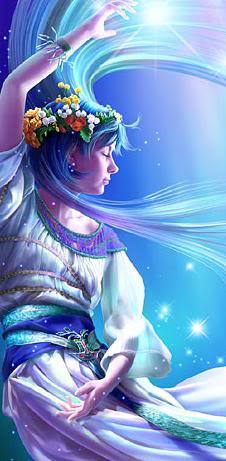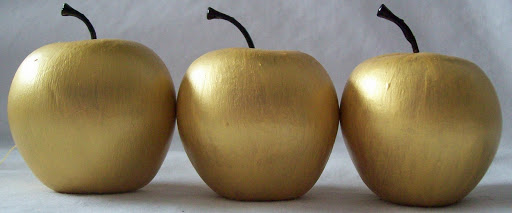Asterope was one of the Pleiades, a star grouping also referred to as the Seven Sisters. Perhaps better known as Hesperia, she was the wife or lover of Aesacus and daughter of Cebren (Erebus) and Nyx.
 She was the mother of Peneleos by Hippalcimus. He was an Achaean soldier in the Trojan War. She was also the mother of Acragas by Zeus.
She was the mother of Peneleos by Hippalcimus. He was an Achaean soldier in the Trojan War. She was also the mother of Acragas by Zeus.
Aterope was an Oceanid, which is one of the races of Naiad Nymphs of the River Kebren (Cebren) in the Troad. In Greek mythology, the Hesperides was the collective name for the nymphs of the evening and golden light of sunset, and who were the “Daughters of the Evening” or “Nymphs of the West”. They tend a blissful garden in a far western corner of the world, located near the Atlas mountains in North Africa at the edge of the encircling Oceanus, the world-ocean.
By Ancient Roman times, the garden of the Hesperides had lost its archaic place in religion and had dwindled to a poetic convention, in which form it was revived in Renaissance poetry, to refer both to the garden and to the nymphs that dwelt there.
Hesperia or Hesper is the Greek goddess of the evening star in Greek mythology. It is one of the stars in the Pleiades. The name Hesperia means originating from Hesperus, the evening star Venus, equivalent to vesper, or it means ‘Light of Evening’ — a reference to the setting sun. She was in charge of watering the sacred apple tree. Ordinarily the Hesperides number three, like the other Greek triads (the Three Graces and the Moirai).
They are sometimes portrayed as the evening daughters of Night (Nyx) either alone, or with Darkness (Erebus).
Among the names given to them, though never all at once, there were either three, four, or seven Hesperides. Hesiod says that these “clear-voiced Hesperides”, daughters of Night, guarded the golden apples beyond Ocean, gives the number of the Hesperides as three, and their names as: Aigle (or Aegle, “dazzling light”), Erytheia (or Erytheis) and ox-eyed Hesperethusa (“sunset glow”, alternatively Hesperathusa, Hesperarethusa).
Pseudo-Apollodorus gives the number of the Hesperides as four, named: Aigle, Erytheia, Hesperia (or Hesperie) and Arethusa. Fulgentius gives four Hesperides, named: Aegle, Hesperie, Medusa and Arethusa. Apollonius of Rhodes gives their names as Aigle, Erytheis and Hespere (or Hespera). Hyginus in his preface to the Fabulae names them as Aegle, Hesperie and Aerica. In another source, they are named Ægle, Arethusa and Hesperethusa, the three daughters of Hesperus.
An ancient vase painting gives the following names for the four: Asterope, Chrysothemis, Hygieia and Lipara.
On another, seven names are given Aiopis, Antheia, Donakis, Kalypso, Mermesa, Nelisa and Tara.
Petrus Apianus attributed to these stars a mythical connection of their own. He believed that they were the seven Hesperides, nymph daughters of Atlas and Hesperis. Their names were: Aegle, Erythea, Arethusa, Hestia, Hespera, Hesperusa and Hespereia in the far west of the world. They are sometimes called the Western Maidens, the Daughters of Evening or Erythrai, and the “Sunset Goddesses”, designations all apparently tied to their imagined location in the distant west.
Hesperis is appropriately the personification of the evening (as Eos is of the dawn) and the Evening Star is Hesperus. In addition to their tending of the garden, they were said to have taken great pleasure in singing.
After Heracles completed his first ten Labours, Eurystheus gave him two more claiming that neither the Hydra counted (because Iolaus helped Heracles) nor the Augean stables (either because he received payment for the job or because the rivers did the work). The first of these two additional Labours was to steal the apples from the garden of the Hesperides. Heracles first caught the Old Man of the Sea, the shape-shifting sea god, to learn where the Garden of the Hesperides was located.
In some variations, Heracles, either at the start or at the end of his task, meets Antaeus, who was immortal as long as he touched his mother, Gaia, the earth. Heracles killed Antaeus by holding him aloft and crushing him in a bearhug.
Herodotus claims that Heracles stopped in Egypt, where King Busiris decided to make him the yearly sacrifice, but Heracles burst out of his chains.

Finally making his way to the Garden of the Hesperides, Heracles tricked Atlas into retrieving some of the golden apples for him, by offering to hold up the heavens for a little while (Atlas was able to take them as, in this version, he was the father or otherwise related to the Hesperides). This would have made this task – like the Hydra and Augean stables – void because he had received help.
Upon his return, Atlas decided that he did not want to take the heavens back, and instead offered to deliver the apples himself, but Heracles tricked him again by agreeing to take his place on condition that Atlas relieve him temporarily so that Heracles could make his cloak more comfortable. Atlas agreed, but Heracles reneged and walked away, carrying the apples. According to an alternative version, Heracles slew Ladon instead.
There is another variation to the story where Heracles was the only person to steal the apples, other than Perseus, although Athena later returned the apples to their rightful place in the garden. They are considered by some to be the same “apples of joy” that tempted Atalanta, as opposed to the “apple of discord” used by Eris to start a beauty contest on Olympus (which caused “The Siege of Troy”).
On Attic pottery, especially from the late fifth century, Heracles is depicted sitting in bliss in the Gardens of the Hesperides, attended by the maidens.

Fiona, the Flower Fairy Sculpture
